BLUES
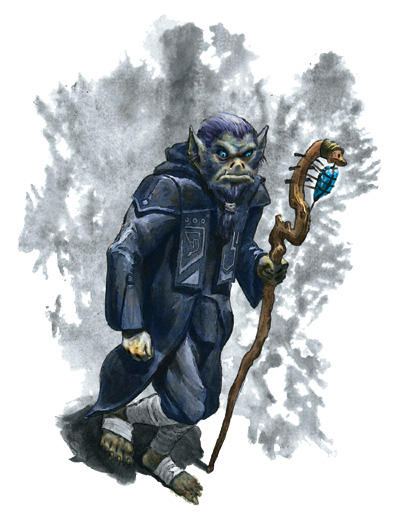
Blues are a subrace of goblins with an innate knack for psionics. Their bluish skin sets them apart from other goblins immediately - which often makes them a target not just of goblin enemies but also of other goblins. Enlightened goblin communities attempt to preserve their blues, since those that survive to adulthood augment the tribe.
A blue is often smaller than an average goblin, standing just about 3 feet tall and weighing about 40 pounds. Blues have noticeably blue-tinged skin, and their eyes are less dull than those of a common goblin. Otherwise, they resemble their kin. They generally dress in short leather robes, dyed black.
Blues are often poorly integrated into their goblin tribes. Common goblins rail against them (but not in their presence), and leaders don't trust them. It is not uncommon for blues to be killed by their own kin out of fear. As a result, blues are often extremely paranoid - those that survive do so because they have become cruel, cunning, and dangerous. Blues usually live apart in caves of their own, but since they depend on the tribe for protection, they do not often stray too far.
In a tribe containing more than one blue, a "Blue Council" may secretly gain control and thereafter manipulate the titular leader from behind the scenes. Such tribes are far more dangerous than those that slay their blues early on.
Blues tend to be psions, although blues raised in communities where their kind are rare may choose the path of the wilder. Blues support goblin warriors in combat and are often called upon to lead a gang of goblins (from the rear) into battle.
BLUE RACIAL TRAITS
-
-2 Strength, +2 Intelligence, -2 Charisma.
-
Small size: +1 bonus to Armor Class, +1 bonus on attack rolls, +4 bonus on Hide checks, -4 penalty on grapple checks, lifting and carrying limits 3/4 of those of Medium characters.
-
Blue base land speed is 30 feet.
-
Darkvision out to 60 feet.
-
Naturally Psionic: Blues gain 1 bonus power point at 1st level.
-
Racial Skills: A blue character has a +4 racial bonus on Move Silently checks and Ride checks.
-
Automatic Languages: Common, Goblin. Bonus Languages: Draconic, Elven, Giant, Gnoll, Orc.
-
Favored Class: Psion.
-
Level Adjustment: +1.
DROMITES
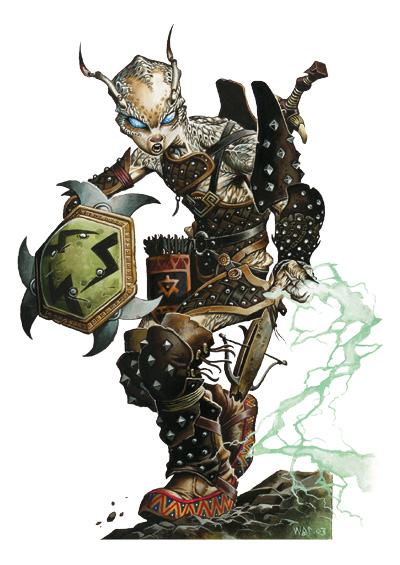
Dromites might be mistaken for halflings at a distance, due to their diminutive stature. However, closer scrutiny reveals dromites to have hardened, chitin-encrusted skin, compound eyes like those of an insect, and two small antennae protruding from their brows. Called "bug-men" by the ignorant, dromites share far more traits with humans than they do with insects. One major difference between dromites and most other races is their androgynous physiology. Aside from their Grand Queen (female) and their Elected Consort (male), dromites are genderless and possess no sexual characteristics.
Personality: Dromites vary in their temperament, but each usually exhibits one of four personality types, depending on the caste that dromite eventually joins. Those of the Fire Caste are often quick to anger, but also quick to laugh and forgive. Those of the Ice Caste are analytical, slow to make decisions, but often right. Those of the Voice Caste are consummate artists, reveling in all types of performance, especially song. Those of the Glimmer Caste always move at high speed, rarely resting in their pursuit of life's tasks. Each caste identifies with the energy type associated with its creed: fire, cold, sonic, and electricity, respectively. The four major castes are important to dromites, but are not the race's only form of social organization. Despite being a sexless society, dromites form close emotional bonds with others of their race, especially within the confines of self-selected groups known as life bonds. These relationships are similar to what other races refer to as marriages, but a life bond usually contains more than two members. As older members of a life bond die, new members are brought in, so a life bond persists long after the original members are no longer a part of it. A single life bond may contain members of several castes.
Physical Description: Dromites stand about 3 feet tall. They are essentially humanoid in appearance, if a bit thin. Their chitinous skin provides dromites with some protection against injury. Dromites have no body hair; where a humanoid might possess a head of hair, a dromite has a thin coating of convoluted chitin that smoothly rises from its skin and extends down the back of its head, neck, and the rest of its body. Dromites are not fully covered in chitin, but it is noticeable on their shoulders, torsos, the backs of their hands, and other vulnerable spots (including their heads). A dromite's eyes are striking - sparkling, almost luminescent orbs, subdivided into hundreds of tiny cells. Two small antennae sprout from its head; they move in accordance with the creature's actions or moods. They wear heavy boots and light clothing, sometimes nothing more than a sturdy harness for holding and carrying gear.
Relations: Dromites are accepting of other races, though other races sometimes find them a bit too exotic (giving rise to the derogatory term "bug-man"). Half-orcs and humans seem the most prone to using the name, apparently acting out of some inner fear of or prejudice against insects - despite the dromites' nearly humanoid appearance.
Alignment: Dromites tend toward no particular alignment, not even neutral. The best and the worst are found among them.
Dromite Lands: Dromite city-hives can be found under any land, but are usually secret and have only a few openings to the surface or to some other subterranean location. Since dromites are naturally psionic and adherents of the psionic arts (especially psychokinesis), some city-hives have no physical outlets to the surface or surrounding subterranean tunnels - dromites use permanent psionic portals and psionic powers to get into and out of these most secure city-hives. Despite the location of their hidden cities, dromites have no particular desire to remain underground, and in fact seem driven to spend at least some time on the surface. Thus, some dromites may be found living temporarily or permanently in a humanoid community - if it is one that accepts a variety of races.
Each dromite city-hive contains at least one Grand Queen with female characteristics, and one Elected Consort with male characteristics. Both queen and consort are elected on a yearly basis from a pool of the most prominent city-hive residents. After participating in a special communal ceremony, they take on titular leadership roles and assume their gender characteristics. Their most important responsibility is to provide a year's worth of dromite eggs, which hatch in well-guarded nurseries located in the city-hive's core. From the eggs come dromite infants, which look more or less like most humanoid infants (except that they have antennae).
Religion: Dromites hold their Grand Queen and Elected Consort in highest regard, almost as if deities. Because the Grand Queen and Elected Consort are almost completely occupied by their responsibility to keep the race populous, they rarely make pronouncements as a true leader would - but when they do have something to say about a topic, everyone listens.
Language: Dromites speak Common. Some learn Terran, which allows them to better communicate with other creatures of the subterranean world.
Names: Dromites, when born, are chosen from the nurseries by adult dromites who have entered life bonds. The adopted dromite is named by its new "parents" according to the traditions of the life bond. Thus, dromites have a first name and a life bond family name.
First Names: Demisse, Elimu, Fela, Gebre, Idi, Idrissa, Kato, Matunda, Obi, Sefu, Vita, Xolu.
Life Bond Family Names: Adanech, Dedanech, Fanech, Gyalech, Marimech, Massawech, Nikech, Ulech.
Adventurers: Dromites who are curious about life beyond the city-hive have little trouble securing permission to venture forth and seek their fortunes. Unless a city-hive is actively expanding its borders, an excess of population leads to cramped quarters. Thus, even the less than willing are sometimes pushed out into the world, on a mission not of their choosing.
DROMITE RACIAL TRAITS
-
+2 Charisma, -2 Strength, -2 Wisdom: Dromites are self-willed go-getters, but do not always show the best judgment.
-
Monstrous Humanoid: Dromites are not subject to spells or effects that affect humanoids only, such as charm person or dominate person.
-
Small: As a Small creature, a dromite gains a +1 size bonus to Armor Class, a +1 size bonus on attack rolls, and a +4 size bonus on Hide checks, but it uses smaller weapons than humans use, and its lifting and carrying limits are three-quarters of those of a Medium character.
-
Dromite base land speed is 20 feet.
-
Chitin: A dromite’s skin is hardened, almost like an exoskeleton, and grants the character a +3 natural armor bonus to AC and one of the following kinds of resistance to energy: cold 5, electricity 5, fire 5, or sonic 5. The player chooses what type of energy resistance is gained when the character is created. (This choice also dictates which caste the dromite belongs to.) This natural energy resistance stacks with any future energy resistance gained through other effects.
-
Naturally Psionic: Dromites gain 1 bonus power point at 1st level. This benefit does not grant them the ability to manifest powers unless they gain that ability through another source, such as levels in a psionic class.
-
Psi-Like Ability: 1/day - energy ray. A dromite always deals the kind of energy damage that its chitin has resistance to (for example, a dromite who has resistance to cold 5 deals cold damage with its energy ray). Manifester level is equal to 1/2 Hit Dice (minimum 1st). The save DC is Charisma-based.
-
Scent: Its antennae give a dromite the scent ability. A dromite can detect opponents by scent within 30 feet. If the opponent is upwind, the range increases to 60 feet; if downwind, it drops to 15 feet. Strong scents, such as smoke or rotting garbage, can be detected at twice the ranges noted above. Overpowering scents, such as skunk musk or troglodyte stench, can be detected at triple normal range. When a dromite detects a scent, the exact location of the source is not revealed - only its presence somewhere within range. The dromite can take a move action to note the direction of the scent. Whenever the dromite comes within 5 feet of the source, the dromite pinpoints the source’s location.
-
Blind-Fight: Its antennae also give a dromite Blind-Fight as a bonus feat.
-
Compound Eyes: This feature of its anatomy gives a dromite a +2 racial bonus on Spot checks.
-
Automatic Languages: Common. Bonus Languages: Dwarven, Gnome, Goblin, Terran.
-
Favored Class: Wilder.
-
Level Adjustment: +1.
DUERGAR
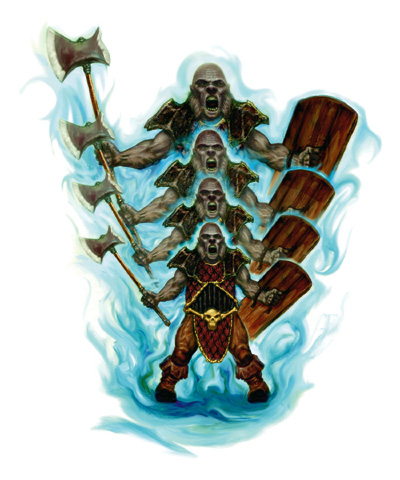
The duergar, or gray dwarves, are grim folk who lead lives of neverending toil in great underground foundry-cities. The typical duergar realm is every bit as powerful, cruel, and wealthy as a great city of the drow. Duergar cities exist only for the manufacture of wealth through unending labor. Duergar are the preeminent smiths and traders of the Underdark, and duergar caravans travel vast distances deep beneath the surface. Duergar are sullen, insular, and tireless workers. They tend to be better neighbors than drow, but they are always eager to acquire new slaves to supply their labor needs. The duergar don't waste slaves in the sort of cruel spectacles other evil races enjoy - they simply work their captives to death.
Personality: Gray dwarves have few good points aside from courage and determination. They are avaricious, shorttempered, sullen, violent, and ungrateful. Duergar nurse grudges for a lifetime and never stop counting the slights (real or imagined) they've received. They believe that might makes right, and they have no pity for those who are too weak to defend their property or themselves. On the positive side, duergar believe in minding their own business (so long as other folks don't have anything they want) and working hard to excel at their chosen crafts. No obstacle daunts a gray dwarf who has settled on a goal. Duergar may not have much loyalty to anyone other than themselves, but they never leave a job half done.
Physical Description: Gray dwarves stand 4 to 4-1/2 feet tall, but are lean and hard compared to other dwarves. Their skin is a dull gray, and their eyes are black and cold. Male duergar don't have hair above their ears, but they often boast short, wiry beards of iron-gray or black. Most females are likewise bald, but some have short-cropped hair of dull black.
Relations: Duergar are universally disliked by all other societies, and even have trouble getting along with each other. They are churlish and hateful, and they have nothing to do with folk of other races unless they stand to gain something by it. Of the other races commonly encountered underground, duergar find svirfneblin (deep gnomes) the least irritating, since the gnomes are also outstanding artisans who value hard work. Duergar can't stand drow (dark elves), sensing condescension and mockery behind the elves' courtesy. Duergar absolutely loathe other kinds of dwarves as well as mind flayers because, according to duergar legends, thousands of years ago the rest of dwarfkind abandoned the gray dwarves to thralldom and misery under mind flayer rule.
Alignment: Gray dwarves are generally evil, placing little value on the lives and property of others. They are consumed by envy for those better off than they, and have not a trace of pity for those not as fortunate. A fair number of duergar simply want nothing more than to be left alone, and so they lean toward hardhearted neutrality. Few gray dwarves are good-aligned.
Religion: The patron deity of the gray dwarves is Laduguer, a joyless deity of toil. Duergar spend little time or effort on any sort of religious observances, feeling that the best way to venerate their grim god is to work.
Language: Gray dwarves speak Dwarven and Undercommon.
Names: A duergar's clan name is often based on his or her chosen profession. Clan names can change over time as clans take up different occupations or win honors in battle.
Male Names: Bruthwol, Horgar, Ivar, Murgol, Thangardt.
Female Names: Brilmara, Dorthis, Olga, Ulara, Weltha.
Clan Names: Coalhewer, Firehand, Goldcrown, Hammerhead, Ironthew, Steelshadow.
Adventurers: Few gray dwarves have any time for nonsense, which is how they view adventuring. However, individuals with no stomach for a life of unceasing toil occasionally appear in duergar society, and these rare gray dwarves often find it expedient to strike out on their own before their fellows decide that they're not pulling their weight. Other gray dwarf adventurers are exiles or fugitives, driven out of their home cities by the vicious feuds that arise between rival clans.
DUERGAR RACIAL TRAITS
-
+2 Constitution, -4 Charisma: Duergar are hardy but sullen and mean-spirited.
-
Medium: As Medium creatures, duergar have no special bonuses or penalties due to their size.
-
Duergar base land speed is 20 feet. However, gray dwarves can move at this speed even when wearing medium or heavy armor or when carrying a medium or heavy load (unlike other creatures, whose speed is reduced in such situations).
-
Darkvision out to 120 feet.
-
Immunity to paralysis, phantasms, and poison.
-
+2 racial bonus on saves against spells and spell-like effects.
-
Stability: Duergar are exceptionally stable on their feet. A duergar receives a +4 bonus on ability checks made to resist being bull rushed or tripped when standing on the ground (but not when climbing, flying, riding or otherwise not standing firmly on the ground).
-
Stonecunning: This ability grants a duergar a +2 racial bonus on Search checks to notice unusual stonework, such as sliding walls, stonework, traps, new construction (even when built to match the old), unsafe stone surfaces, shaky stone ceilings, and the like. Something that isn’t stone but that is disguised as stone also counts as unusual stonework. A gray dwarf who merely comes within 10 feet of unusual stonework can make a Search check as if he were actively searching, and a duergar can use the Search skill to find stonework traps as a rogue can. A duergar can also intuit depth, sensing his approximate depth underground as naturally as a human can sense which way is up. Duergar have a sixth sense about stonework, an innate ability that they get plenty of opportunity to practice and hone in their underground homes.
-
Psi-Like Abilities: 1/day - expansion, invisibility. These abilities affect only the duergar and whatever he carries. Manifester level is equal to Hit Dice (minimum 3rd).
-
Naturally Psionic: Duergar gain 3 bonus power points at 1st level. This benefit does not grant them the ability to manifest powers unless they gain that ability through another source, such as levels in a psionic class.
-
+1 racial bonus on attack rolls against orcs (including half-orcs) and goblinoids (including goblins, hobgoblins, and bugbears).
-
+4 dodge bonus to Armor Class against creatures of the giant type (such as ogres, trolls, and hill giants).
-
Light Sensitivity (Ex): Duergar are dazzled in sunlight or within the radius of a daylight spell.
-
Duergar have a +4 racial bonus on Move Silently checks and a +1 racial bonus on Listen and Spot checks. They have a +2 racial bonus on Appraise and Craft checks that are related to stone or metal.
-
Automatic Languages: Common, Dwarven, Undercommon. Bonus Languages: Draconic, Giant, Goblin, Orc, Terran.
-
Favored Class: Fighter.
- Level Adjustment: +1.
ELANS
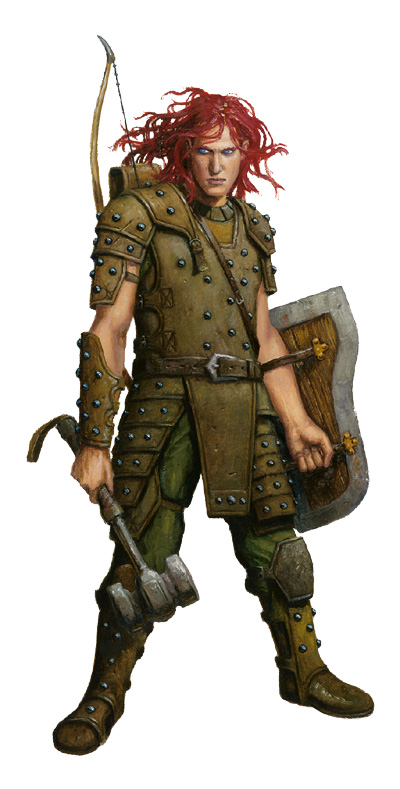
Elans are not born; they are made. Living humans are selected from a pool of applicants and screened by a special elan council. Those who pass muster undergo a secret psionic process in one of several hidden elan enclaves, where they abandon their humanity for a new, psionically energized existence. Thus, elans do not reproduce biologically, but rather psionically, through a mysterious psionic ritual known only to elans. Even then, their "children" are usually already fully formed adult humans. Nonhuman elans are never created, and it could be that the ritual simply doesn't work for any creatures but those who were originally human.
When those who are still human seek the transformation to elans, they must petition existing elans for the privilege of going through the process. Elans are a secret lot in this regard, and do not publicly reveal their enclaves or places of making; the elans select new aspirants and turn away those they feel are unsuited for life as an elan. Newly created elans retain the basic memories and personalities of their previous human lives, but lose all their previous class levels, skills, and other characteristics; a newly created elan is a 1st-level character, free to reinvent himself as a member of his new race.
Personality: Elans are nearly as adaptable, flexible, and ambitious as the humans from which they are made. Because their exceedingly long life spans sometimes lead the living to think the worst of them, elans practice a certain restraint, especially with regard to the subject of their origin. Otherwise, their personalities vary widely.
Physical Description: Elans typically stand just under 6 feet tall and weigh around 180 pounds, with males generally taller and heavier than females. Because the council members who make the selection of aspirants have their own preferences, elans of a certain "generation" often share certain physical characteristics. The current council members favor aspirants with pale skin, red hair, and a youthful quality. Overall, elans vary in looks as widely as humans do. An elan dresses in a style typical of the area in which she lives (to all the better pass herself off as human), including the adoption of unusual hairstyles, fanciful clothes, tattoos, body piercing, and the like.
Elans have effectively unlimited life spans. As long as they are not destroyed, their mental arts could conceivably continually energize and rebuild their bodies for a thousand years or more. Elans do not sleep as members of most other races do. Instead, an elan meditates in a deep trance for 4 hours a day. An elan resting in this fashion gains the same benefit that a human does from 8 hours of sleep. While in this trance, an elan concentrates on suffusing her body with psionic energy, healing the hurts of the day, and restoring animation and resiliency to her tissues.
Relations: Elans mix with members of other races, especially humans. It is probable that their relations would undergo a shift should their true nature become widely known, so one of the essential tenets of elan existence is secrecy.
Alignment: Elans tend toward no particular alignment, not even neutral. The best and the worst are found among them.
Elan Lands: Wherever humans are found, there too are elans.
Religion: Elans are less likely to worship a deity than members of other races, since they feel that any grace or continued existence they might hope for depends on their own efforts and the continual mastery of their inborn psionic talent.
Language: Elans speak Common. They typically learn other languages, including obscure ones, and they are fond of sprinkling their speech with words borrowed from other tongues: Orc curses, Halfling culinary terms, Elven musical expressions, Dwarven military phrases, and so on.
Names: Elan names vary greatly, and an elan's name is often simply the human name she possessed before entering into her new existence. This is particularly true when an elan wishes to pick up her old life where it left off. Others view their second chance at existence as an opportunity to start anew, and they pick new names. Titles, though they are used only among themselves, are important to elans. Freshly transformed elans have the title of Newmade; those who have lived at least a few decades after transformation have the title of Made; and those over a century old have the title of Eternal. Those who belong to the council that chooses new elans have the title of Culler.
Adventurers: Elan adventurers are akin to humans in their daring and ambition. Because many effects that hurt humans leave elans unscathed, elans sometimes seem extraordinarily brave to those who don't know their true natures.
ELAN RACIAL TRAITS
-
-2 Charisma: Elans, despite their attempts to blend into the human population, continue to come off as just a little unusual.
-
Aberration: Elans are not subject to spells or effects that affect humanoids only, such as charm person or dominate person.
-
Medium: As Medium creatures, elans have no special bonuses or penalties due to their size.
-
Elan base land speed is 30 feet.
-
Elans (unlike most aberrations) do not have darkvision.
-
Naturally Psionic: Elans gain 2 bonus power points at 1st level. This benefit does not grant them the ability to manifest powers unless they gain that ability through another source, such as levels in a psionic class.
-
Resistance (Su): Elans can use psionic energy to increase their resistance to various forms of attack. As an immediate action, an elan can spend 1 power point to gain a +4 racial bonus on saving throws until the beginning of her next action.
-
Resilience (Su): When an elan takes damage, she can spend power points to reduce its severity. As an immediate action, she can reduce the damage she is about to take by 2 hit points for every 1 power point she spends.
-
Repletion (Su): An elan can sustain her body without need of food or water. If she spends 1 power point, an elan does not need to eat or drink for 24 hours.
-
Automatic Language: Common. Bonus Languages: Any (other than secret languages, such as Druidic). Elans’ past lives expose them to wide ranges of language.
-
Favored Class: Psion.
-
Level Adjustment: +0.
GITHYANKI
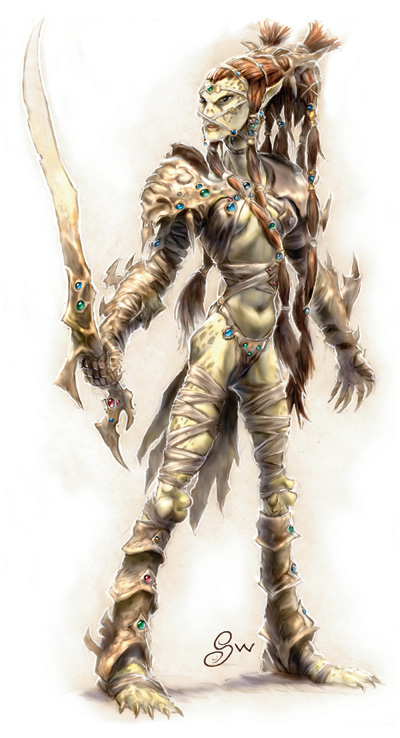
Githyanki are an ancient race of martial humanoids residing on the Astral Plane. From their astral citadels, they launch countless raids against unfortunate Material Plane lands, carrying off booty and slaves to serve them in their extraplanar castles. Widely known as planar travelers and marauders, githyanki venture to all corners of the multiverse in search of power and wealth.
Personality: Most githyanki are cruel, rapacious marauders who revel in warfare and conquest. They are extraordinarily arrogant, and view other humanoids native to the Material Plane with nothing less than utter contempt. Even the most open-minded githyanki is smugly convinced of his own ability to handle any kind of trouble that might arise on whatever backwater plane he happens to be traveling through, and many are bitingly sarcastic and rude to those they perceive as their inferiors. While others may find them caustic and condescending, githyanki are often ambitious, clever, and uncomplaining in adversity - qualities that make them well suited to the vicissitudes of the adventurer's life. They are not particularly loyal allies and make few friends, but they are fearsome and tireless foes who don't know when to quit.
Physical Description: Githyanki are tall, gaunt humanoids averaging a little over 6 feet tall and typically weighing around 170 pounds. They have rough, yellow skin and russet hair, which they often pull back into a pair of topknots. Their noses are almost flat, their eyes have a sinister gleam, and their ears are sharply pointed. Githyanki favor ornate and complex clothing and weapons.
Relations: Most githyanki regard Material Plane denizens as ignorant bumpkins at best - or, at worst, slaves that haven't been captured yet. A few githyanki rise above these conceits and come to value the skills and knowledge of those they encounter in their travels - but these individuals are uncommon, to say the least. Regardless of what they think of Material Plane inhabitants, githyanki burn with hatred for the ancient enemies of their race - the mind flayers, who once enslaved them, and the githzerai, who betrayed the teachings of the great leader Gith (as the githyanki see it). No githyanki will pass up a chance to work harm against either of these foes. In the presence of both, they are inclined to first join with the githzerai to dispose of the mind flayers, and then turn on their alienated kinfolk once the illithids are no more.
Alignment: Most githyanki are ambitious, cruel, selfcentered, and violent. They favor evil alignments, particularly neutral evil and chaotic evil. Those who have decided to turn their backs on their native society are neutral or chaotic neutral. Very few githyanki are lawful or good.
Githyanki Lands: Githyanki are natives of the Astral Plane. They live in great drifting citadels and trade outposts clinging to odd bits of astral matter, like rocky islands in a silver sea. Githyanki must use psionic plane shift or similar dimension-crossing effects to come to the Material Plane (it is assumed that any githyanki player character has already done so at the beginning of his career).
Religion: Githyanki have little use for deities, but all must pay homage to the terrible lich-queen who rules their race. The lich-queen is not a deity and grants no spells to her followers, but she jealously destroys any githyanki who openly venerates a god. A few githyanki clerics exist, worshiping deities who reward ambition and power, but they must conceal their practices while among their fellows.
Language: Githyanki speak Gith, a language they share with the githzerai. They also speak Common.
Names: A githyanki's primary allegiance is to his clan, so his clan name is usually given first when addressing strangers. A githyanki also has an individual name, to which he does not attach much importance.
Clan Names: Druustya, Fiden-sither, Githom-vaas, Totherka, Saamasal, Zuriith-movya.
Male Names: Baarya, Duuth, Fiden, Flomm, Kastya, Klavya, Saath, Zith, Zomm.
Female Names: Amith, Efromm, Ifrith, Iliss, Olavya, Ummon, Usamm, Ysviden.
Adventurers: The githyanki respect power, and for many of them the path to power lies in the pursuit of magical and psionic abilities, wealth, and knowledge. Many githyanki strike out on their own to comb the planes for the power they need to gain station and prestige among their own kind. More rarely, githyanki who become disenchanted with their race's cruelty and callousness choose to leave and make their own way in the world. In a remote corner of the Material Plane, a githyanki expatriate might be simply an odd-looking traveler judged by his own deeds or misdeeds, not the depredations of his malicious kind.
GITHYANKI RACIAL TRAITS
-
+2 Dexterity, +2 Constitution, –2 Wisdom: Agile and hardy, githyanki tend to be impatient and overconfident.
-
Medium: As Medium creatures, githyanki have no special bonuses or penalties due to their size.
-
A githyanki’s base land speed is 30 feet.
-
Darkvision out to 60 feet.
-
Naturally Psionic: Githyanki gain 3 bonus power points at 1st level. This benefit does not grant them the ability to manifest powers unless they gain that ability through another source, such as levels in a psionic class.
-
Psi-Like Abilities: As a githyanki advances in level, he gains psi-like abilities as indicated on the table below. The benefits are cumulative. Manifester level is equal to 1/2 Hit Dice (minimum 1st). The save DCs are Charisma-based.
Level Psi-Like Abilities 1st 3/day - far hand, psionic daze 3rd 3/day - concealing amorpha 6th 3/day - psionic dimension door 9th 3/day - telekinetic thrust; 1/day - psionic plane shift -
Power Resistance (Ex): A githyanki has power resistance equal to his Hit Dice +5.
-
Automatic Languages: Common, Gith. Bonus Languages: Abyssal, Celestial, Draconic, Infernal, Undercommon.
-
Favored Class: Fighter.
-
Level Adjustment: +2.
GITHZERAI
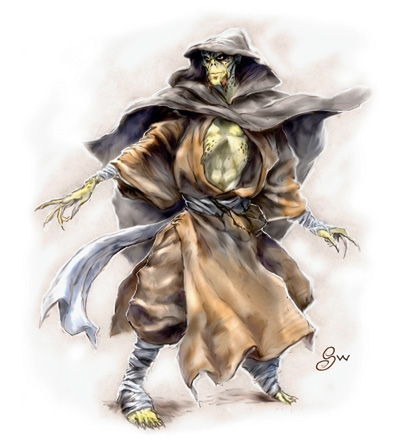
Thousands of years ago, the githyanki and the githzerai comprised a single humanoid race held in thrall by the dreaded mind flayers. After the mythic hero Gith led the race to freedom from their illithid masters, the ancient gith divided into the two rival races they have been ever since. While the githyanki pursued a path of cruel aggression, martial power, and arcane might, the githzerai turned their attention to the mysteries of the inner self and became a race of ascetics who harness the power of the mind and the spirit. They travel far and wide across the planes, opposing the sinister plots of both mind flayers and their own githyanki kin.
Personality: Githzerai rarely use two words when one will do. They tend to be cynical and suspicious, and they generally expect the worst in people. Githzerai don't waste time on fools, and are rarely moved to help those unprepared to help themselves. They are pragmatic to a fault, slow to give trust, and cautious in their dealings with others. Many githzerai disdain creature comforts and live their lives in ascetic discipline. Their settlements and strongholds resemble monasteries more than villages.
Physical Description: Githzerai closely resemble githyanki. Like their kin, they are tall, gaunt humanoids averaging a little over 6 feet tall and typically weighing around 160 pounds. They have rough, yellow skin and russet hair, although they habitually shave their heads. Their noses are almost flat, their eyes are dull yellow or gray, and their ears are pointed. Githzerai favor drab robes and avoid ostentatious dress.
Relations: Unlike githyanki, githzerai are not particularly contemptuous of Material Plane races and rarely trouble Material Plane inhabitants. They simply view Material Plane folk as irrelevant and don't waste much time on them. Those Material Plane natives who demonstrate discipline, resolve, and an understanding of the planes are given the respect their abilities merit. While githzerai are usually calm and disciplined in their conduct, they feel nothing but cold, purposeful hatred for githyanki and mind flayers. They also have a bitter rivalry with the slaadi; despite that, the two races cooperate sometimes when faced with a common danger.
Alignment: Githzerai tend to be pragmatic and selfserving, but they are not malicious and do not look to get ahead at the expense of others. Most are neutral with respect to good or evil.
Githzerai Lands: Githzerai are native to the plane of Limbo, where they dwell in drifting cities and monasteries amid the swirling protomatter. Like githyanki, they must use psionic plane shift or similar dimension-crossing effects to come to the Material Plane (it is assumed that any gith zerai player character has already done so at the beginning of his career).
Religion: Githzerai are not particularly religious and rarely venerate any deity. Instead, they seek enlightenment within their own minds. They revere the immortal wizard-king of their race, but they do not worship him and do not gain divine spells from their reverence.
Language: Githzerai speak Gith, a language they share with the githyanki. They also speak Common.
Names: Githzerai do not place much importance on family or clan, preferring to organize their society by merit. They have developed a wealth of traditional titles and ranks that are awarded to individuals as they become warranted, and they refer to one another by simple names in daily life.
Titles: Zerth, Ur-zerth, Fell Hand, Master of Elements, Planewalker, Swordthane, Spellthane, Rrathmal, Storvakal.
Male Names: Dak, Duurth, Ferzth, Greth, Hurm, Kalla, Muurg, Nurm, Shrakk.
Female Names: Adaka, Adeya, Ella, Ezhelya, Immilzin, Izera, Uweya.
Adventurers: Githzerai are self-sufficient and form few attachments to home or family. As a result, many are noted wanderers who need little reason to set off on journeys across the planes. To a githzerai, the physical journey is a metaphor for the inner one, and many adventurers are content to pass year after year in remote Material Plane lands.
GITHZERAI RACIAL TRAITS
-
+6 Dexterity, +2 Wisdom, –2 Intelligence: Githzerai are incredibly quick and agile, and they trust intuition more than logic.
-
Medium: As Medium creatures, githzerai have no special bonuses or penalties due to their size.
-
A githzerai’s base land speed is 30 feet.
-
Darkvision out to 60 feet.
-
Naturally Psionic: Githzerai gain 2 bonus power points at 1st level. This benefit does not grant them the ability to manifest powers unless they gain that ability through another source, such as levels in a psionic class.
-
Psi-Like Abilities: 3/day - inertial armor, psionic daze, catfall, concussion. Githzerai of 11th level also gain plane shift 1/day. Manifester level is equal to 1/2 Hit Dice (minimum 1st). The save DCs are Charisma-based.
-
Power Resistance (Ex): A githzerai has power resistance equal to her Hit Dice +5.
-
Automatic Languages: Common, Gith. Bonus Languages: Abyssal, Celestial, Draconic, Slaad, Undercommon.
-
Favored Class: Monk.
-
Level Adjustment: +2.
HALF-GIANTS
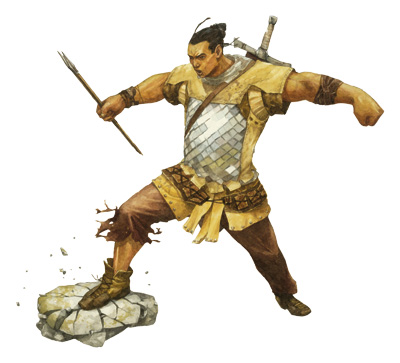
Half-giants are a cross between humans and giants, bred into existence in a desert land by cruel sorcerer-kings intending to use them as warriors and laborers. Every half-giant who was born and survived early childhood could look forward to nothing but a life of suffering, as with any people kept in bondage. Some half-giants found that their forced breeding had engendered within them a spark of psionic power. With the aid of this secret power, many half-giants escaped their circumstances to seek a new home deep in the desert, where they are free to discover their own destiny.
Personality: Half-giants, for the most part, retain human sensibilities. They are curious, interested in cooperation and communication, and have a general tendency toward kindness. (Of course, there are exceptions.) They are quick to pick up the morals, customs, and habits of the areas in which they settle down.
Physical Description: Half-giants typically stand from 7 feet to nearly 8 feet tall, and weigh from 250 to 400 pounds, with men noticeably taller and heavier than women. Most half-giants have tightly braided black hair and deep coppery complexions. Half-giants often prefer grandiose dress when they can afford it, sporting fanciful or intimidating clothing.
Relations: Most other humanoids are put off by half-giants due to their abnormally large size. In fact, many are first taken for young (if strangely well-groomed) hill giants. Upon getting past their initial trepidation, however, most other humanoids find half-giants of good alignment to be outgoing, kind creatures.
Alignment: Most half-giants are good-aligned, but all alignments can be found within their ranks.
Half-Giant Lands: Half-giants recently settled in the deepest part of the hot deserts to the south. Of the land they came from, half-giants speak little, other than to say that where they live is similar to where they once toiled.
Religion: Half-giants, as a rule, have a particular disdain for religion, sometimes going out of their way to speak badly of a deity. It's not that they don't believe in deities, but that they don't believe that a deity always has the best interests of its worshipers at heart. Individual half-giants have enough courtesy and sensibility to keep their observations to themselves when in the company of a good companion with pious inclinations. A few half-giants even take up the cloth themselves.
Language: Half-giants speak Common. Those with higher than average intelligence often learn Giant.
Names: Half-giants have a childhood name and a given name, the latter usually bestowed by friends or by the community in which the half-giant originally grew up. Most half-giant names reflect some aspect of the desert land that the half-giants inhabit, though a few strange place names are also thrown in (apparently remembered from their former homes of long ago).
Male Given Names: Sandking, Dunewalker, Sunharrower, Drywell, Stormrider, Desertstrider, Saltwalker, Raam.
Female Given Names: Oasis, Sandrose, Breath, Goldfl ower, Sweetwater, Raincaller, Nibenay.
Adventurers: Half-giants have already traveled far to found their desert settlements. For some, wanderlust is a way of life, and seeking after glory, fortune, or even a life of high adventure is something any half-giant can understand and accept - though most of them are content to stay in their settlements and listen to the tales of faraway lands from those who have adventured there.
HALF-GIANT RACIAL TRAITS
-
+2 Strength, +2 Constitution, -2 Dexterity: Half-giants are tough and strong, but not too nimble.
-
Giant: Half-giants are not subject to spells or effects that affect humanoids only, such as charm person or dominate person.
-
Medium: As Medium creatures, half-giants have no special bonuses or penalties due to their size.
-
Half-giant base land speed is 30 feet.
-
Low-Light Vision: A half-giant can see twice as far as a human in starlight, moonlight, torchlight, and similar conditions of poor illumination. He retains the ability to distinguish color and detail under these conditions.
-
Fire Acclimated: Half-giants have a +2 racial bonus on saving throws against all fire spells and effects. Half-giants are accustomed to enduring high temperatures.
-
Powerful Build: The physical stature of half-giants lets them function in many ways as if they were one size category larger.
Whenever a half-giant is subject to a size modifier or special size modifier for an opposed check (such as during grapple checks, bull rush attempts, and trip attempts), the half-giant is treated as one size larger if doing so is advantageous to him.
A half-giant is also considered to be one size larger when determining whether a creature’s special attacks based on size (such as improved grab or swallow whole) can affect him. A half-giant can use weapons designed for a creature one size larger without penalty. However, his space and reach remain those of a creature of his actual size. The benefits of this racial trait stack with the effects of powers, abilities, and spells that change the subject’s size category. -
Naturally Psionic: Half-giants gain 2 bonus power points at 1st level. This benefit does not grant them the ability to manifest powers unless they gain that ability through another source, such as levels in a psionic class.
-
Psi-Like Ability: 1/day - stomp. Manifester level is equal to 1/2 Hit Dice (minimum 1st). The save DC is Charisma-based.
-
Automatic Language: Common. Bonus Languages: Draconic, Giant, Gnoll, Ignan.
-
Favored Class: Psychic warrior.
-
Level Adjustment: +1.
MAENADS
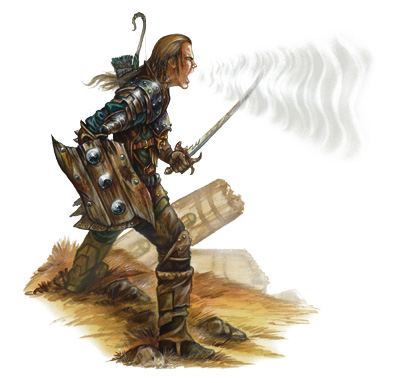
Maenads are a race rumored to be wildly emotional, but perceived as extremely reserved by those who encounter them. In fact, both rumor and perception are true: Maenads have developed strict self-control as a means of holding their intense emotional turmoil at bay. On the rare occasion when a maenad loses his control, a flood of emotion rises to the surface, often to be released in acts of stunning bravery or violence. Maenads have a strong martial bent, useful for venting the passions they keep bottled up. Maenads know not the source of their spiritual anger, but legend has it that they were terribly wronged by a higher power in some distant time. Some tales suggest that the maenads were a race of bestial creatures who were able to contain their mad frenzy only after overthrowing their own deity.
Personality: Maenads seem discreet and calm, restrained and undemonstrative, unwilling to use a sentence when a word will do, and happier still with a gesture if words can be dispensed with altogether. To maintain a life in civilized lands and even (or especially) among themselves, maenads must practice a discipline of mental calm, lest the fury of their racial memories break forth.
Physical Description: Maenads are tall and wiry, standing over 6 feet tall and typically weighing around 200 pounds, with maenad males the same height as and only marginally heavier than maenad females. They wear the dark hair on their heads long and braided (and have no hair elsewhere on their bodies). Their skin is dusted with a peculiar sparkle, as of gem dust, giving them a striking luster in the right light. This sparkle is a natural component of their skin, which is flecked with bits of living crystal. Maenads possess grace and fine features, and are almost elven in their beauty. They prefer heavier clothing, and wear armor if it's available.
Relations: Maenads are most comfortable with humans, finding that race's various temperaments not too dissimilar to their own. They respect the dwarves' ability to hold a grudge. Maenads are particularly taken with elves; the elves' lightness of being is a balm to the maenad spirit. Maenads don't dislike halflings, gnomes, or xephs, but have a hard time understanding their capricious ways.
Alignment: Maenads know that self-control is their best path to a fulfilling life. Thus, they lean strongly toward law. Generally, they value and protect others' self-control as well as their own, and so are good-aligned more often than not.
Maenad Lands: For the most part, maenads live in coastal communities with populations less than three hundred. Their well-hidden villages blend into the cliffs and surf. They hunt some game inland but gather most of their nourishment out at sea in light, cunningly built boats. Some maenads use their boats for commerce up and down the coast, trading pearls and grown crystal sculptures. Maenads encountered in human lands are usually warriors for hire or adventurers.
Religion: Maenads worship various minor deities of the sea. Obad-Hai, as he relates to the seas and oceans, is also a deity known to the maenads.
Language: Maenads speak a language governed by strict rules of grammar. Chants play an important part in their songmaking and literature. They use the Elven alphabet for their script.
Names: Maenad names are given and used much like human names. Every maenad has at least one given name and a family name.
Male Names: Alberik, Alrik, Basilius, Erland, Gunnar, Isak, Ragnor, Rurik, Tor.
Female Names: Agaton, Annalina, Blenda, Eleonora, Gala, Lena, Malin, Ragnara, Vedis.
Family Names: Coebelliantus, Hjalmar, Kolbjorn, Perchnosius, Torborn, Valborg, Valentin, Xaljorn.
Adventurers: Some maenads take up adventuring out of a desire to travel and see the world. Others become adventurers because they tend to get along easier with those less given to inner rage than with others like themselves.
MAENAD RACIAL TRAITS
-
Medium: As Medium creatures, maenads have no special bonuses or penalties due to their size.
-
Maenad base land speed is 30 feet.
-
Naturally Psionic: Maenads gain 2 bonus power points at 1st level. This benefit does not grant them the ability to manifest powers unless they gain that ability through another source, such as levels in a psionic class.
-
Psi-Like Ability: 1/day - energy ray. A maenad can deal only sonic damage with this ability. It is accompanied by a tremendous scream of rage. Manifester level is equal to 1/2 Hit Dice (minimum 1st). The save DC is Charisma-based.
-
Outburst (Ex): Once per day, for up to 4 rounds, a maenad can subjugate her mentality to gain a boost of raw physical power. When she does so, she takes a -2 penalty to Intelligence and Wisdom but gains a +2 bonus to Strength.
-
Automatic Languages: Common, Maenad. Bonus Languages: Aquan, Draconic, Dwarven, Elven, Goblin. Maenads commonly know the languages of their enemies and of their friends, as well as Draconic, the language commonly found in ancient tomes of secret knowledge.
-
Favored Class: Wilder.
SYNADS
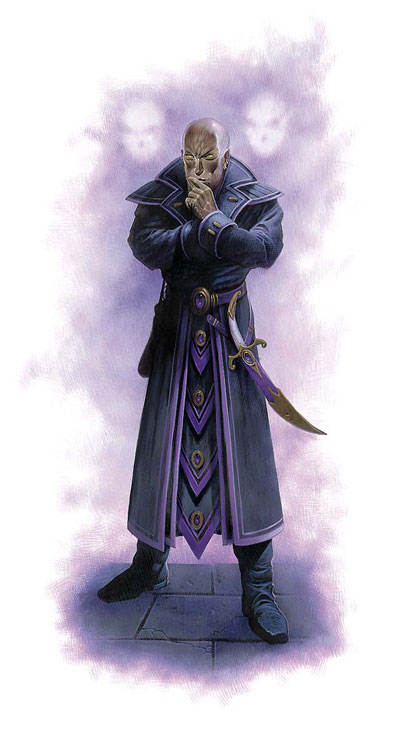
Synads seem unsocial to the naive. In truth, each synad is a group unto himself, composed of three fully independent minds that are fused into a cooperating whole. While most races suffer the crushing loneliness of a wholly closed-off mind, synads reap the benefits of combined thought, cooperative planning, and multiple viewpoints on each new task or topic.
Personality: While synads have wildly varying personalities, their threefold minds give the race recognizable personality traits. A synads threefold mind is composed of parts that are often referred to as the overmind, the collective, and the oracle. In most activities, the overmind controls the synad's actions. However, sometimes the collective or the oracle - the parts known as the submind - rises to the surface, either bypassing the overmind or mentally advising it on topics the submind is more suited to understand.
Physical Description: In the bright light of day, a synad passes for a tall, slim human. In dim light, however, out of the corner of an observer's eye, a synad sometimes appears as a humanoid with three heads. The normal head appears bracketed by two ghostly heads completely "devoid of hair, eyes, ears, mouth, or nose. This happens only if the synad has exhausted all its power points for the day. For this reason, most synads avoid draining their power point reserve, lest their true nature be revealed. Synads typically stand just over 6 feet tall and weigh about 170 pounds, with males somewhat taller and heavier than females. Synads are typically hairless. They have pale skin, large, dark eyes, and long, expressive fingers. They dress commonly but enjoy impressive, flamboyant headwear.
Relations: Synads mix with members of other races, especially humans. Sometimes those relations change suddenly when another creature gains insight into a synad's true nature, so synads try to avoid dim light when possible, or else they prepare their comrades by revealing the truth about their heritage.
Alignment: Synads do not tend toward any particular alignment. The best and the worst are found among them.
Synad Lands: Synads hail from a parallel world accessible through the Plane of Shadow. The few who dwell on the Material Plane prefer to forget their world of origin, claiming that monstrosities of the mind roam there unhindered.
Religion: Synads often worship Fharlanghn, drawn to his aspect as a traveler. Those who have escaped their homeworld give credit to the deity for showing them a way through.
Language: Synads speak Common and their own unique language.
Names: Synad names vary greatly, mainly because synads have thrown off their original ways and adopted human culture. They draw their names from the names of humans in the area where they have settled. Synads who mate and produce children often name them after local heroes or great leaders.
Adventurers: Synad adventurers are akin to humans in their daring and ambition. Because a synad's threefold mind can withstand mental effects (such as charm person and dominate person) that might leave another creature drooling or subservient, the race has a reputation for great toughness of mind.
SYNAD RACIAL TRAITS
-
Aberration: As aberrations, even though they can appear human, synads are not subject to spells or effects that affect only humanoids.
-
Medium: Synads have no special bonuses or penalties due to their size.
-
Darkvision out to 60 feet.
-
Synad base land speed is 30 feet.
-
Naturally Psionic: Synads gain 3 bonus power points at 1st level, one each for the overmind, the collective, and the oracle. This does not grant synads the ability to manifest powers unless they gain that ability through another source, such as levels in a psionic class.
-
Threefold Mind (Su): The threefold synthesis of mind, controlled by the overmind, grants synads an advantage when resisting mental attacks. They gain a +2 bonus on Will saving throws.
-
Oracle (Su): The part of a synad's mind known as the oracle grants him a daily precognitive edge. This translates into a +2 insight bonus that the synad can apply at any time to an initiative check, attack roll, or saving throw. In the case of an attack roll or saving throw, the synad can elect to apply the bonus to the roll or save after he determines whether his unmodified roll misses. A synad can apply only one precognitive edge per day.
-
Collective (Su): The part of a synad's mind known as the collective allows him to tap into a racial network of knowledge and information. A synad can spend 1 power point as a free action to gain a +2 bonus on any Knowledge or Psicraft check he makes.
-
Multitask (Su): A synad's threefold mind can temporarily separate, allowing him to take more than a single mental action during his turn. Once per day, a synad can spend 1 power point to gain a swift action that he can use to take any purely mental action. Examples include manifesting a psionic power or making a Knowledge, Psicraft, or other check requiring only mental cogitation. However, a synad can use his extra mental action to manifest a power only if the normal actions allowed to him during the round do not also involve manifesting a power.
-
Automatic Languages: Common and Synad. Bonus Languages: Any (other than secret languages, such as Druidic). The portion of a synad's mind known as the collective exposes him to a wide range of languages.
-
Favored Class: Any. A multiclass synad's first chosen new class does not count when determining whether he takes an XP penalty for multiclassing.
THRI-KREEN
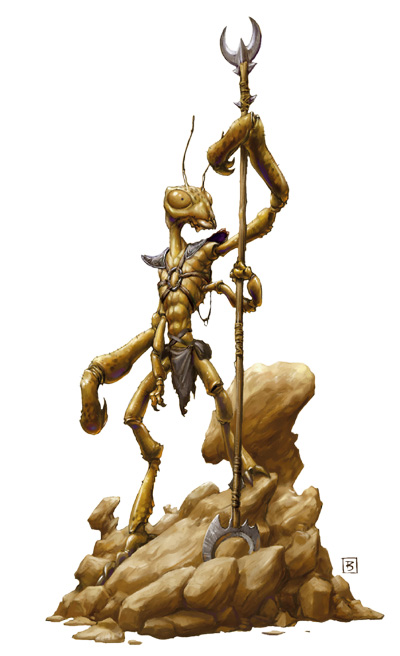
Fierce hunters and faultless trackers, the thri-kreen are a race of insect-folk sometimes known as "mantis warriors." They are inscrutable, alien creatures; those who do not know them well believe them to be bloodthirsty monsters. Nomadic folk who spend their brief lives roaming vast distances of the deserts, scrublands, and savannas of the south, thri-kreen are near-perfect hunters.
Personality: Each thri-kreen forms deep attachments with a handful of other individuals, regarding them as clutch-mates, companions to be defended with one's own life if need be. All others outside this small group of companions are strangers and enemies, although thri-kreen are intelligent enough to recognize that one traveling alone in the lands of other folk would be wise to keep such observations to oneself.
Physical Description: A thri-kreen resembles a bipedal praying mantis. Its body's exoskeleton is sandy yellow in color. Of the body's six limbs, the lower two are used for walking, and the upper four end in four-fingered, clawlike hands. Thrikreen have large, dangerous mandibles and compound eyes. Two small antennae sprout from the tops of their heads. They wear little clothing beyond simple harnesses for carrying weapons and equipment.
Relations: Thri-kreen view themselves as noble hunters and judge other folk on the simple relationship of predator to prey. They respect barbarians, rangers, and others who live off the land and treat the land with care. On the other hand, savage and evil races such as gnolls and orcs despoil the lands that should be hunted with respect, and thus they earn the thri-kreen's enmity. The mantis warriors generally regard city folk and farmers of other races as not-hunters, and therefore not worth their attention (but also unworthy of their enmity).
Alignment: Thri-kreen have virtually no social structure other than the clutches they form with their closest allies. The notion of sophisticated rules for social behavior is foreign to them. They are almost always chaotic in alignment, and often neutral with respect to good and evil.
Thri-Kreen Lands: Thri-kreen like it hot. They favor warm, dry climates, especially arid grasslands and plains that most other folk consider uninhabitable. Since they are a nomadic race, they make no permanent settlements and travel light, carrying little more than tools and food from camp to camp.
Religion: Thri-kreen strongly favor a druidic tradition instead of the myriad deities of other races. Thri-kreen druids serve as the spiritual leaders of the race.
Language: Thri-kreen speak their own language, Thri-Kreen, which is composed of clicks, whistles, and snaps of their mandibles. Thri-kreen player characters also speak Common.
Names: Thri-kreen make no distinction between male and female names, and they do not use a surname.
Thri-Kreen Names: Chak-tha, Drik-chkit, Kacht-ta, Kat'chka, Pak'cha, Pik-ik-cha, Ptekwe, Tak-tha, Tik-tik.
Adventurers: Most thri-kreen adventurers are barbarians, rangers, or druids - characters who do well in the wide-open spaces favored by the race. On rare occasions, a thri-kreen hunter falls in with an adventuring party and bonds with its new companions, taking them as clutch-mates in place of its own kind.
THRI-KREEN RACIAL TRAITS
-
+2 Strength, +4 Dexterity, -2 Intelligence, +2 Wisdom, -4 Charisma: Thri-kreen are strong and quick, but they think differently from most humanoids and have a hard time relating to folk of other races.
-
Monstrous Humanoid: Thri-kreen are not subject to spells or effects that affect humanoids only, such as charm person or dominate person.
-
Medium: As Medium creatures, thri-kreen have no special bonuses or penalties due to their size.
-
Thri-kreen base land speed is 40 feet.
-
Darkvision out to 60 feet.
-
Immunity to magic sleep effects.
-
+3 Natural Armor: A thri-kreen's exoskeleton is tough and resistant to blows.
-
Multiple Limbs: Thri-kreen have four arms, and thus can take the Multiweapon Fighting feat instead of the Two-Weapon Fighting feat. Thri-kreen can also take the Multiattack feat. (These are not bonus feats.)
-
Natural Attacks: Thri-kreen can attack with four claws and a bite. The claws deal 1d4 points of damage, and the bite is a secondary attack that also deals 1d4 points of damage. A thri-kreen can attack with a weapon (or multiple weapons) at its normal attack bonus, and make either a bite or claw attack as a secondary attack. For example, a thri-kreen ranger with the Multiweapon Fighting feat who is armed with three short swords could attack with all three swords at a -2 penalty (the normal penalty for fighting with multiple weapons while using light weapons in its off hands) and also make a bite attack at a -5 penalty.
-
Poison (Ex): Bite, initial damage 1d6 Dex, secondary damage paralysis, DC 11 + Con modifier. A thri-kreen produces sufficient poison for only one poisonous bite per day.
-
Leap (Ex): Thri-kreen are natural jumpers. They have a +30 racial bonus on Jump checks.
-
Weapon Familiarity: Thri-kreen can treat gythkas and chatkchas (see the sidebar) as martial weapons rather than exotic weapons.
-
Naturally Psionic: Thri-kreen gain 1 bonus power point at 1st level. This benefit does not grant them the ability to manifest powers unless they gain that ability through another source, such as levels in a psionic class.
-
Psi-Like Abilities: 3/day - chameleon, know direction and location; 1/day - greater concealing amorpha, metaphysical claw. Manifester level is equal to 1/2 Hit Dice (minimum 1st). The save DCs are Charisma-based.
-
Racial Hit Dice: A thri-kreen character begins with two levels of monstrous humanoid, which provide 2d8 Hit Dice, a base attack bonus of +2, and base saving throw bonuses of Fort +0, Ref +3, and Will +3.
-
Racial Skills: A thri-kreen's monstrous humanoid levels give him skill points equal to 5 x (2 + Int modifier). His class skills are Balance, Climb, Hide, Jump, Listen, and Spot.
-
Thri-kreen have a +4 racial bonus on Hide checks in sandy or arid settings.
-
Racial Feats: A thri-kreen character has Deflect Arrows as a bonus feat. In addition, his monstrous humanoid levels give him one feat.
-
Automatic Languages: Common, Thri-Kreen. Bonus Languages: Elven, Giant, Gnoll, Goblin, Halfling.
-
Favored Class: Ranger.
-
Level Adjustment: +2.
UNBODIED
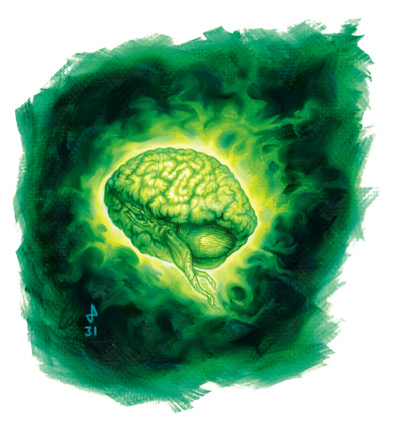
The unbodied are a race of former humanoids that have successfully cast off their physical bodies and now exist as pure mind. However, using its assume likeness ability, an unbodied can take any shape it desires.
The most common forms in which an unbodied appears are a noble human (either male or female) dressed in dramatic fashion, a disembodied brain, or a simple globe of light. But the only real limit to an unbodied's form is the creature's imagination. Some unbodied go about as Large dragons, others as Small animals, and a few in nightmarish assemblages of limbs and goo. When in such physical forms, they do not give off light but mimic a solid, physical presence (though interaction usually reveals their incorporeal nature).
Although their ancestors wished to move on to a higher realm, many unbodied still cling to the wants and cares of the physical world and take pleasure in many of the same sensations a physical creature would, depending on their alignment. A good unbodied enjoys helping others and upholding lofty principles, while an evil one delights in controlling events to suit its own desires.
Unbodied can cause minor disruption in the forms of creatures they touch, but most prefer to use their psionic powers to subdue those who would oppose them.
An unbodied uses telepathy to communicate with others.
UNBODIED RACIAL TRAITS
-
+2 Dexterity, +2 Constitution, +4 Intelligence, +4 Wisdom, +4 Charisma. As an incorporeal creature, an unbodied has no Strength score.
-
Medium size.
-
An unbodied has a fly speed of 30 feet (good maneuverability).
-
Darkvision out to 60 feet.
-
Deflection bonus to Armor Class equal to character's Charisma modifier (minimum +1).
-
Natural Attack: An unbodied can make a melee touch attack to deal 1d6 points of damage.
-
Psionic Powers: An unbodied manifests powers as a 4th-level psion (telepath). An unbodied who takes levels in psion (telepath) adds its racial manifesting ability and psion levels together to determine its power point reserve, manifester level, and powers known. The save DCs are Intelligence-based.
-
Telekinetic Force (Su): An unbodied can use telekinetic force as a standard action that does not provoke attacks of opportunity. Manifester level 4th. The save DC is Charisma-based.
-
Assume Likeness (Su): An unbodied can assume the likeness of any Small, Medium, or Large creature as a standard action that does not provoke attacks of opportunity. Its abilities do not change, but it appears to be that creature, relying on its Bluff and Disguise skills to deflect suspicion.
-
Hide Mind (Su): An unbodied cannot be identified as psionic by divination spells or clairsentience powers.
-
Incorporeal Traits: An unbodied is harmed only by other incorporeal creatures, magic weapons, powers, spells, spell-like abilities, and supernatural abilities. It has a 50% chance to ignore any damage from a corporeal source, except for force effects or attacks made with ghost touch weapons. It can pass through solid objects, but not force effects, at will. Its attacks ignore natural armor, armor, and shields, but deflection bonuses and force effects work normally against them. An incorporeal creature always moves silently and cannot be heard with Listen checks if it doesn't wish to be.
-
Telepathy 100 ft.: An unbodied can communicate telepathically with any other creature within 100 feet that has a language.
-
Racial Hit Dice: An unbodied begins with four levels of monstrous humanoid, which provide 4d8 Hit Dice, a base attack bonus of +4, and base saving throw bonuses of Fort +1, Ref +4, and Will +4.
-
Racial Skills: An unbodied's monstrous humanoid levels give it skill points equal to 7 x (2 + Int modifier). Its class skills are Bluff, Diplomacy, Disguise, Intimidate, Listen, Sense Motive, and Spot. Unbodied have a +4 racial bonus on Bluff checks and Disguise checks. When using its assume likeness ability, an unbodied gets an additional +10 circumstance bonus on Disguise checks. If it can read an opponent's mind, it gets a further +4 circumstance bonus on Bluff and Disguise checks.
-
Racial Feats: An unbodied's monstrous humanoid levels give it two feats.
-
Favored Class: Psion (telepath).
-
Level Adjustment: +4.
XEPHS
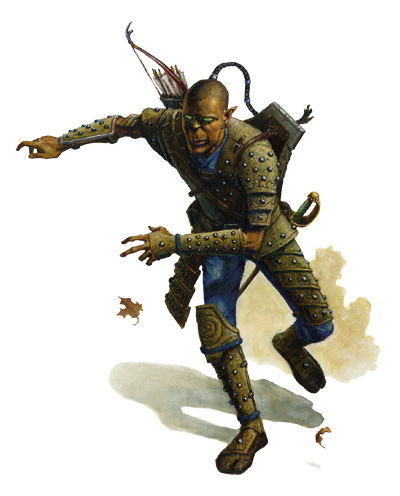
Xephs are acknowledged for their skill in feats of agility, their uncontested ability at generating bursts of speed, their matchless knowledge of movement and distance, and their capacity for humor. Xephs are celebrated for the fabulous objects of subtle beauty they produce for trade. Their lands lie far to the east, contained within a great rift that hides a broad valley permanently plunged into darkness, except for several psionically illuminated forests. Despite the lack of sunlight in this environment, xephs thrive.
Personality: Xephs are quick to laugh or joke, welcoming of strangers, and especially charitable to those who really earn their confidence. If they are betrayed by a friend, xephs are dwarflike in their resolve to seek justice and redress. Xephs value artful sculpture, beautiful paintings, expensive clothing, and other art objects. They prefer to avoid a fight rather than wade in, but they are not timid if combat is their only recourse.
Physical Description: Xephs stand about 5-1/2 feet tall and are slender and graceful, usually weighing about 140 pounds. Males are typically taller and heavier than females. Xephs' skin is typically brown, and their eyes are dark. Their hair is usually black and straight; some wear it clipped short, while others shave their heads except for a topknot and weave that hair into a single long braid.
Relations: Xephs get along well with humans, half-elves, and halflings. They think that elves might be a little too good to be true, while they view half-orcs and half-giants with some suspicion. Xephs and maenads tend to rub each other the wrong way; xephs see maenads as too stiff (little realizing the reason why), while maenads envy xephs their free and easy attitude.
Alignment: Xephs tend toward good. Those who take up the soulknife class learn to be lawful, though on balance, the race is somewhat chaotic.
Xeph Lands: Xeph cities are found far to the east across wide-open savannas, then deep below the lip of a great rift, where darkness reigns. There they practice their arts and sing their songs under the boughs of a gloriously illuminated forest. Members of other races are welcome in the forest, though some ancient temples are off limits to those not of the blood. The wealth the xephs own is due in part to their artistic bent, and in part to their desire to travel far and wide to trade for the wealth and art of other cultures. Some prefer overland caravans, others seagoing ships.
Religion: The chief deity of the xephs is Fharlanghn, the Dweller on the Horizon. He is the deity of travel, roads, distance, and horizons, all of which are concepts that stir the xeph soul.
Language: Xephs speak their own language, which uses the same alphabet as Common. Some also learn Sylvan, the language of fellow wanderers.
Names: A xeph's name is granted to her by her parents on her fourth birthday. Most xeph names are used and reused down through the generations. Xephs who travel usually take the name of their city of birth as a second name, a reminder of where they originally began their journey through life.
Male Names: Assim, Bahram, Behrooze, Cyrus, Jamsheed, Ksathra, Majeed, Mehrdad, Nasim, Shatrevar, Xerxes.
Female Names: Amira, Azar, Cyra, Darya, Jaleh, Marjan, Narda, Shahin, Soraya, Zenda.
Second (City) Names: Asha, Dareh, Feroz, Kurush, Melchior, Saeed, Val.
Adventurers: A xeph adventurer is usually motivated merely by the thought of travel and exploration itself. A xeph may also be motivated by the desire to see new wonders, feats of might, psionics, or magic great enough to inspire the xeph to greater works of personal art.
XEPH RACIAL TRAITS
-
+2 Dexterity, -2 Strength: Xephs are quick but not very strong.
-
Medium: As Medium creatures, xephs have no special bonuses or penalties due to their size.
-
Xeph base land speed is 30 feet.
-
Darkvision out to 60 feet.
-
+1 racial bonus on saving throws against powers, spells, and spell-like effects. Xephs have an innate resistance to psionics and magic.
-
Naturally Psionic: Xephs gain 1 bonus power point at 1st level. This benefit does not grant them the ability to manifest powers unless they gain that ability through another source, such as levels in a psionic class.
-
Burst (Su): Three times per day, a xeph can put on a burst of speed to increase her speed by 10 feet, plus 10 feet per four character levels beyond 1st, to a maximum increase of 30 feet at 9th character level and higher. These bursts of speed are considered a competence bonus to the xeph’s base speed. A burst of speed lasts 3 rounds.
-
Automatic Languages: Common, Xeph. Bonus Languages: Draconic, Elven, Gnoll, Goblin, Halfling, Sylvan.
-
Favored Class: Soulknife.